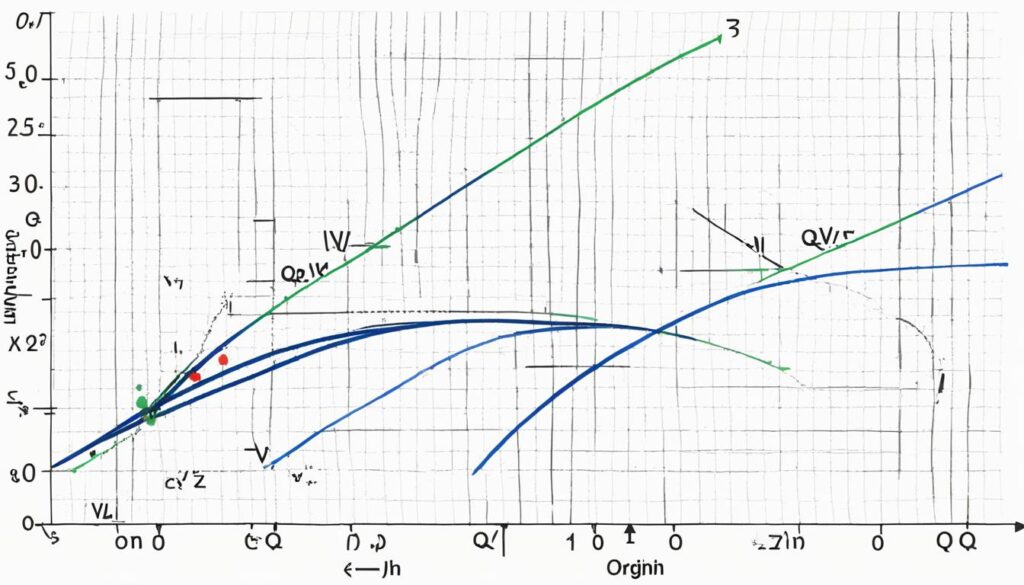Welcome to the world of artificial intelligence! In this article, we will explore the fundamental concepts of Q-values and V-values in the field of reinforcement learning. These concepts play a crucial role in helping AI agents make informed decisions to maximize their rewards.
Reinforcement learning involves an agent learning how to navigate an environment and make decisions based on the available actions. Q-values and V-values come into play by representing the expected values of taking specific actions in a given state and being in a particular state, respectively. By understanding these values, AI agents can learn and improve their decision-making abilities over time.
To help you grasp these concepts better, let’s dive deeper into the world of Q-values, V-values, and their relationship to artificial intelligence.
Contents
- 1 Value Functions in Reinforcement Learning
- 2 Relationship Between V & Q Values in RL
- 3 Q-Learning: An Overview of Model-Free RL
- 4 Q-Table: The Representation of Q-Values
- 5 Conclusion
- 6 FAQ
- 6.1 What are Q-values and V-values?
- 6.2 How do value functions work in reinforcement learning?
- 6.3 What is the relationship between V-values and Q-values?
- 6.4 What is Q-learning and how does it work?
- 6.5 What is a Q-table and how is it used in Q-learning?
- 6.6 How can Q-learning be implemented in Python?
- 6.7 What are some applications of Q-learning in artificial intelligence?
- 6.8 Why are Q-values and V-values important in AI?
- 7 Source Links
Key Takeaways:
- Q-values and V-values are essential in reinforcement learning, a branch of AI.
- Q-values represent the expected value of taking a specific action in a given state.
- V-values represent the expected value of being in a specific state.
- These values guide the decision-making process of AI agents.
- Understanding Q-values and V-values is crucial for grasping the basics of AI and reinforcement learning.
Value Functions in Reinforcement Learning
In reinforcement learning, value functions play a crucial role in estimating the expected return or cumulative reward in different states or state-action pairs. Value functions are essential components in reinforcement learning algorithms, providing guidance for the agent’s decision-making process.
There are two types of value functions:
- State-value function (V(s)): The state-value function represents the expected return starting from a specific state, following a given policy. It estimates the value of being in a particular state and helps the agent assess the attractiveness of different states.
- Action-value function (Q(s,a)): The action-value function represents the expected return starting from a specific state and taking a specific action, while following a given policy. It allows the agent to evaluate the desirability of different actions in a given state.
By estimating the values of states and state-action pairs, these value functions guide the agent’s decision-making process and determine optimal actions.
Value Function Example:
Consider a simple grid world environment where the agent can move in four directions – up, down, left, and right. The state-value function (V(s)) estimates the expected return starting from a specific state, while the action-value function (Q(s,a)) estimates the expected return starting from a specific state and taking a specific action. The values in the table below represent the expected returns for different states and actions:
| State (s) | Action (a) | Value (V(s)) | Action-Value (Q(s,a)) |
|---|---|---|---|
| State 1 | Action 1 | 0.5 | 0.2 |
| State 1 | Action 2 | 0.7 | 0.9 |
| State 2 | Action 1 | 0.3 | 0.6 |
| State 2 | Action 2 | 0.8 | 0.4 |
The value functions enable the agent to assess the quality of different states and state-action pairs, allowing it to make informed decisions and select actions that maximize its expected return.
Value functions are fundamental in reinforcement learning algorithms, such as Q-learning, and are vital for the agent’s learning and decision-making process.
Relationship Between V & Q Values in RL
In the field of reinforcement learning, there exists a significant relationship between V-values and Q-values. These values, integral to the learning process, are derived using the Bellman equations and play a crucial role in guiding an agent’s decision-making process.
The Bellman equation for V(s) allows us to express the value of a specific state as the sum of the expected immediate reward and the discounted value of the next state.
“V(s) = E[R(t+1) + γV(s(t+1))]”
where:
V(s) is the value of state s
E[…] is the expected value
R(t+1) is the immediate reward
γ is the discount factor
V(s(t+1)) is the value of the next state
Similarly, the Bellman equation for Q(s,a) expresses the value of a state-action pair as the expected immediate reward plus the discounted value of the next state-action pair.
“Q(s,a) = E[R(t+1) + γQ(s(t+1), a(t+1))]”
where:
Q(s,a) is the value of state-action pair (s,a)
E[…] is the expected value
R(t+1) is the immediate reward
γ is the discount factor
Q(s(t+1), a(t+1)) is the value of the next state-action pair
These equations provide a mathematical framework for updating and estimating the values of states and actions based on their expected future rewards. By considering the discounted values of the next states and state-action pairs, an agent can make informed decisions and learn the optimal strategies in a given environment.
The relationship between V-values and Q-values is a cornerstone of reinforcement learning, enabling agents to optimize their decision-making process and ultimately improve their performance in various tasks.

| V-Values | Q-Values |
|---|---|
| Represent the expected return in a specific state | Represent the expected return in a specific state-action pair |
| Derived from Q-Values using the Bellman equations | Derived from V-Values using the Bellman equations |
| Guide an agent’s decision-making process | Guide an agent’s decision-making process |
| Updated iteratively based on expected future rewards | Updated iteratively based on expected future rewards |
Q-Learning: An Overview of Model-Free RL
In the world of reinforcement learning, Q-learning stands out as a popular algorithm that paves the way for model-free learning. Unlike other algorithms that rely on a pre-existing model of the environment, Q-learning learns directly from interactions with the environment, making it highly adaptable and efficient.
The fundamentals of Q-learning revolve around using Q-values to determine the best action to take in a given state. These Q-values represent the expected future rewards an agent can accumulate by taking a specific action in a particular state.
By iteratively updating the Q-values based on the rewards received and the maximum Q-value of the next state, the Q-learning algorithm gradually learns which actions yield the highest overall rewards. This allows the agent to make informed decisions, optimizing its behavior over time.
Q-learning has found success in various domains, including game-playing and autonomous control. In game-playing scenarios, Q-learning enables agents to learn optimal strategies and outmaneuver human players. In autonomous control applications, Q-learning equips vehicles with the ability to learn and optimize their driving behaviors.
With its model-free approach, Q-learning offers flexibility and adaptability, making it a powerful tool in the field of reinforcement learning. Over the years, Q-learning has proven its efficacy in tackling complex problems and delivering remarkable results.
Q-Table: The Representation of Q-Values
In Q-learning, a Q-table is used to store and represent the Q-values for different state-action pairs. The Q-table serves as a structured representation of the agent’s learned knowledge about the environment. It is a two-dimensional table that organizes the Q-values based on the possible states and actions.
The structure of a Q-table is simple but powerful. The rows of the table represent the states, while the columns represent the actions that can be taken in those states. Each cell of the table contains the Q-value, which represents the expected cumulative reward for taking a specific action in a particular state.
Here is an example of how a Q-table might look:
| State | Action 1 | Action 2 | Action 3 |
|---|---|---|---|
| State 1 | 0.23 | 0.78 | 0.54 |
| State 2 | 0.12 | 0.52 | 0.39 |
| State 3 | 0.65 | 0.42 | 0.78 |
The Q-table is initially populated with random or zero values. As the agent interacts with the environment and receives rewards, it updates the Q-values in the table based on the observed outcomes. Through repetition and exploration, the agent gradually learns to assign higher Q-values to more rewarding actions in each state.
The Q-table serves as a crucial tool for decision-making. When the agent is in a particular state, it refers to the Q-table to select the action with the highest Q-value. By doing so, the agent exploits its learned knowledge to make informed choices and maximize its cumulative reward over time.

Another area where Q-learning is applied is in robotics. Q-learning allows robots to learn how to navigate and perform tasks in complex environments. By using Q-values, robots can make informed decisions and optimize their actions based on the expected rewards, enhancing their overall performance and adaptability.
In addition, Q-learning has proven to be beneficial in the development of autonomous vehicles. By incorporating Q-learning algorithms, these vehicles can learn and optimize their driving behaviors in real-world scenarios. The vehicles adapt their decision-making processes based on the Q-values, ensuring safer and more efficient navigation.
Overall, the applications of Q-learning in artificial intelligence are extensive and diverse. Its versatility and effectiveness have led to its utilization in game-playing algorithms, robotics, and autonomous vehicles. Q-learning continues to play a crucial role in enhancing AI systems’ abilities to learn and make intelligent decisions in complex environments.
Conclusion
In conclusion, Q-values and V-values play a crucial role in the field of artificial intelligence, specifically in reinforcement learning. These values represent the expected returns in different states and state-action pairs, providing guidance for intelligent decision-making. Q-learning, a popular model-free reinforcement learning algorithm, utilizes Q-values to determine the best actions to take in a given state. By storing and updating these Q-values in a Q-table, the agent can learn and make informed decisions.
The applications of Q-learning are vast and diverse. It has been successfully utilized in game-playing algorithms, allowing AI agents to master complex games and outperform human players. Additionally, Q-learning has made significant contributions to the fields of robotics and autonomous vehicles, enabling intelligent navigation and performance of tasks in diverse and challenging environments.
In order to fully grasp the fundamentals of artificial intelligence and reinforcement learning, it is crucial to understand the concepts of Q-values and V-values. These values shape the learning process and empower AI agents to optimize their decision-making abilities. By continuously refining and accumulating knowledge, these agents can adapt to various scenarios and drive further advancements in the field of AI.
FAQ
What are Q-values and V-values?
Q-values represent the expected value of taking a particular action in a given state, while V-values represent the expected value of being in a specific state.
How do value functions work in reinforcement learning?
Value functions estimate the expected return in a state or state-action pair. There are two types: state-value function (V(s)) and action-value function (Q(s,a)).
What is the relationship between V-values and Q-values?
V-values can be derived from Q-values and vice versa using the Bellman equations. These equations update and estimate the values of states and actions based on expected future rewards.
What is Q-learning and how does it work?
Q-learning is a model-free reinforcement learning algorithm that uses Q-values to determine the next best action in a given state. It learns directly from interactions with the environment.
What is a Q-table and how is it used in Q-learning?
A Q-table is a two-dimensional table that stores and represents the Q-values for different state-action pairs. The agent uses it to select actions based on the highest Q-values.
How can Q-learning be implemented in Python?
Q-learning implementation in Python involves defining the environment, rewards, actions, and Q-table. The Q-table is iteratively updated based on rewards and the maximum Q-value of the next state.
What are some applications of Q-learning in artificial intelligence?
Q-learning has been applied in game-playing algorithms, robotics, and autonomous vehicles to learn optimal strategies, navigation, and driving behaviors, respectively.
Why are Q-values and V-values important in AI?
Q-values and V-values are fundamental concepts in reinforcement learning, allowing agents to learn and improve their decision-making abilities in various AI applications.




